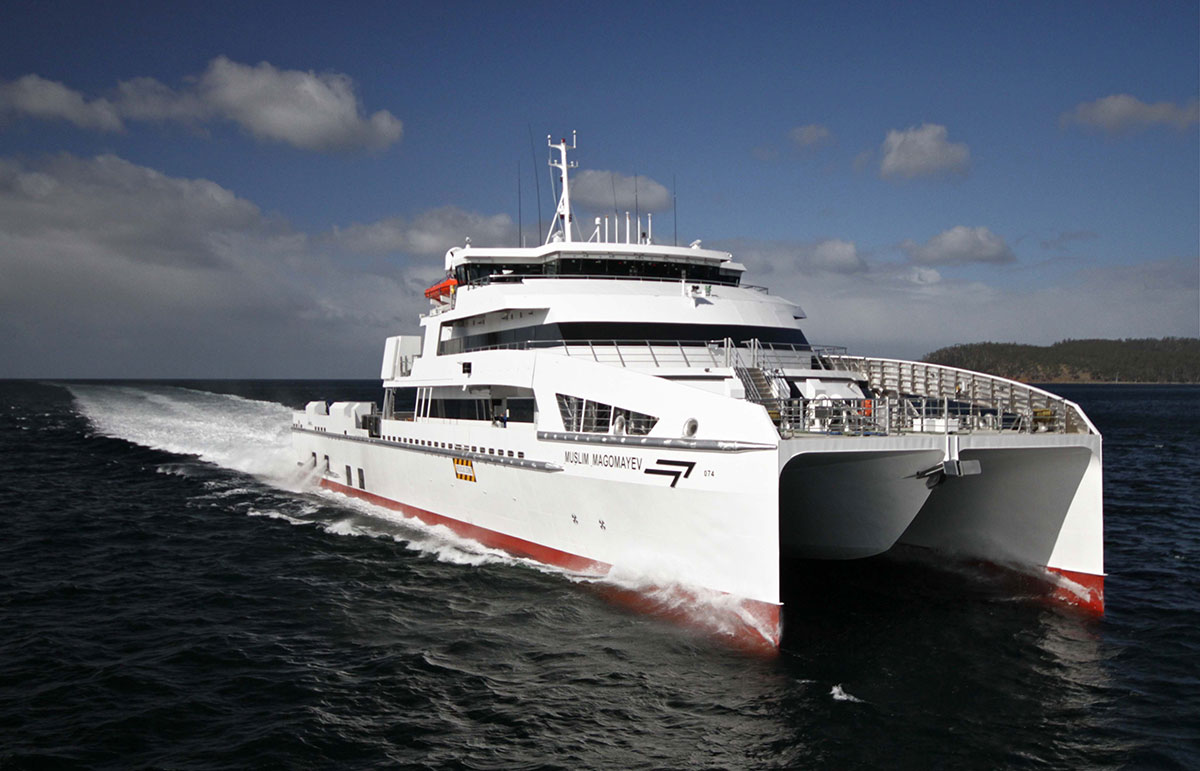On Sept. 15, the 70m fast crew boat (FCB) was christened Muslim Magomayev at a ceremony at the Incat shipyard in Hobart, Tasmania.
This is the first vessel that Australian Shipbuilder Incat Tasmania has purpose built for the oil and gas industry. When sea trials are completed the boat will depart later this month to Baku, Azerbaijan.
During construction over the past year the fast crew boat has been referred to simply as Incat hull 074 but is now bearing the name Muslim Magomayev in honor of Azerbaijan’s famous opera and popular music singer Muslim Magomayev who died in 2008. Magomayev was a renowned entertainer not just in Azerbaijan but all the former Soviet states, often dubbed as their answer to Sinatra.
This first of type DP2 class 70m vessel is being delivered to Caspian Marine Services to operate fast crew transfers for 150 offshore workers to multiple installations in the Caspian Sea. The high speed of the 70m. FCB will allow operational efficiency over helicopter transfer for both passengers and cargo, while the semi-SWATH hull design, along with active ride control, will reduce stress on passengers so they arrive at an oil platform relaxed and fit to work.
Muslim Magomayev has approximately 200 tonnes deadweight and is capable of carrying 150 passengers and 14 crew, along with 130 tonnes of deck cargo, in up to 40-knot wind and seas of 3m significant wave height. The 275 square metre cargo deck will allow the vessel to complete cargo hot shots over a range of 400 nm at speeds of up to 35 knots.
Passengers are accommodated on both the main and mid-deck, the main deck also housing two VIP rooms, storage areas and an equipped workshop, while crew cabins and galley are on the mid-deck.
The vessel’s 16m beam is far narrower than is usual for an Incat catamaran but determined by the width of the Volga-Don Canal that it must transit on its delivery from Hobart, Tasmania, to Baku in Azerbaijan.
Muslim Magomayev will be the world’s largest high speed crew catamaran vessel operating in the global oil and gas industry, according to Incat.
The power for Incat hull 074 is supplied by four 2880kW MTU engines each turning Hamilton HT 900 waterjets. Anticipated design speed was 36 knots with an efficient service speed of 30 knots at full load and 90% MCR, sea trials have not yet been completed, but on her first day on the water the vessel comfortably achieved 38.7 knots lightship.
The ship has been constructed of lightweight marine grade aluminium over the past year at Incat Tasmania’s Derwent Park Hobart shipyard, with concept design by Incat Crowther of Sydney and production engineering by Revolution Design (Incat Tasmania’s design team). It is the first craft Incat has built to the DNV Clean Design notation, giving it a “Green Passport”.
The vessel’s electronic installations are extensive with an expansive wheelhouse to accommodate the range of high tech systems required for the dynamic positioning.
Crew transfer is completed primarily by the Amplemann system, a stabilized access platform, providing a stable deck and gangway to safely transfer between the offshore platform and the vessel. The access platform compensates for the vessel’s motion by using six hydraulic cylinders. The FCB will hold station with four control stations each utilizing Hamilton Jet’s MECS control system integrating with a DNV DYNPOS-AUTR dynamic positioning system. This system provides improved safety during crew transfers in conditions up to sea state 4.




